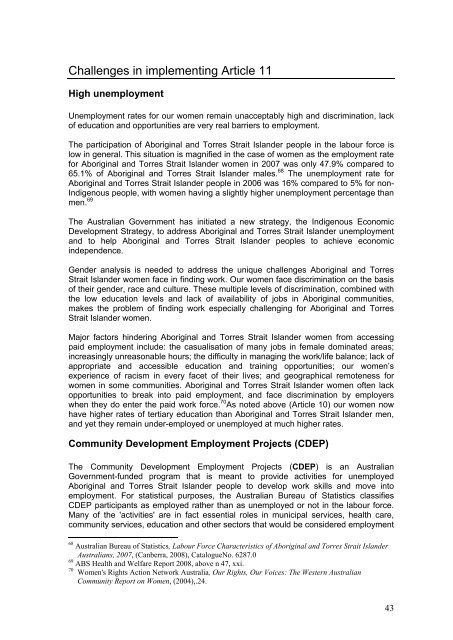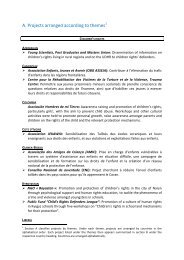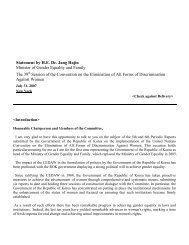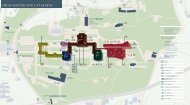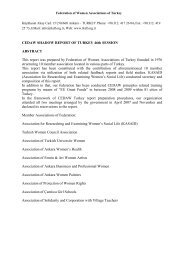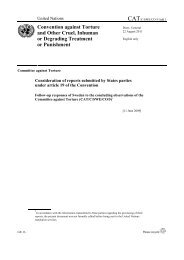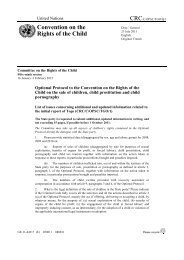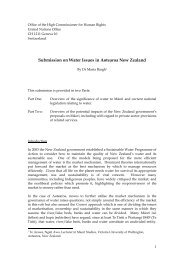Australian Aboriginal and Torres Strait Islander Women's Parallel ...
Australian Aboriginal and Torres Strait Islander Women's Parallel ...
Australian Aboriginal and Torres Strait Islander Women's Parallel ...
You also want an ePaper? Increase the reach of your titles
YUMPU automatically turns print PDFs into web optimized ePapers that Google loves.
Challenges in implementing Article 11High unemploymentUnemployment rates for our women remain unacceptably high <strong>and</strong> discrimination, lackof education <strong>and</strong> opportunities are very real barriers to employment.The participation of <strong>Aboriginal</strong> <strong>and</strong> <strong>Torres</strong> <strong>Strait</strong> Isl<strong>and</strong>er people in the labour force islow in general. This situation is magnified in the case of women as the employment ratefor <strong>Aboriginal</strong> <strong>and</strong> <strong>Torres</strong> <strong>Strait</strong> Isl<strong>and</strong>er women in 2007 was only 47.9% compared to65.1% of <strong>Aboriginal</strong> <strong>and</strong> <strong>Torres</strong> <strong>Strait</strong> Isl<strong>and</strong>er males. 68 The unemployment rate for<strong>Aboriginal</strong> <strong>and</strong> <strong>Torres</strong> <strong>Strait</strong> Isl<strong>and</strong>er people in 2006 was 16% compared to 5% for non-Indigenous people, with women having a slightly higher unemployment percentage thanmen. 69The <strong>Australian</strong> Government has initiated a new strategy, the Indigenous EconomicDevelopment Strategy, to address <strong>Aboriginal</strong> <strong>and</strong> <strong>Torres</strong> <strong>Strait</strong> Isl<strong>and</strong>er unemployment<strong>and</strong> to help <strong>Aboriginal</strong> <strong>and</strong> <strong>Torres</strong> <strong>Strait</strong> Isl<strong>and</strong>er peoples to achieve economicindependence.Gender analysis is needed to address the unique challenges <strong>Aboriginal</strong> <strong>and</strong> <strong>Torres</strong><strong>Strait</strong> Isl<strong>and</strong>er women face in finding work. Our women face discrimination on the basisof their gender, race <strong>and</strong> culture. These multiple levels of discrimination, combined withthe low education levels <strong>and</strong> lack of availability of jobs in <strong>Aboriginal</strong> communities,makes the problem of finding work especially challenging for <strong>Aboriginal</strong> <strong>and</strong> <strong>Torres</strong><strong>Strait</strong> Isl<strong>and</strong>er women.Major factors hindering <strong>Aboriginal</strong> <strong>and</strong> <strong>Torres</strong> <strong>Strait</strong> Isl<strong>and</strong>er women from accessingpaid employment include: the casualisation of many jobs in female dominated areas;increasingly unreasonable hours; the difficulty in managing the work/life balance; lack ofappropriate <strong>and</strong> accessible education <strong>and</strong> training opportunities; our women’sexperience of racism in every facet of their lives; <strong>and</strong> geographical remoteness forwomen in some communities. <strong>Aboriginal</strong> <strong>and</strong> <strong>Torres</strong> <strong>Strait</strong> Isl<strong>and</strong>er women often lackopportunities to break into paid employment, <strong>and</strong> face discrimination by employerswhen they do enter the paid work force. 70 As noted above (Article 10) our women nowhave higher rates of tertiary education than <strong>Aboriginal</strong> <strong>and</strong> <strong>Torres</strong> <strong>Strait</strong> Isl<strong>and</strong>er men,<strong>and</strong> yet they remain under-employed or unemployed at much higher rates.Community Development Employment Projects (CDEP)The Community Development Employment Projects (CDEP) is an <strong>Australian</strong>Government-funded program that is meant to provide activities for unemployed<strong>Aboriginal</strong> <strong>and</strong> <strong>Torres</strong> <strong>Strait</strong> Isl<strong>and</strong>er people to develop work skills <strong>and</strong> move intoemployment. For statistical purposes, the <strong>Australian</strong> Bureau of Statistics classifiesCDEP participants as employed rather than as unemployed or not in the labour force.Many of the 'activities' are in fact essential roles in municipal services, health care,community services, education <strong>and</strong> other sectors that would be considered employment68 <strong>Australian</strong> Bureau of Statistics, Labour Force Characteristics of <strong>Aboriginal</strong> <strong>and</strong> <strong>Torres</strong> <strong>Strait</strong> Isl<strong>and</strong>er<strong>Australian</strong>s, 2007, (Canberra, 2008), CatalogueNo. 6287.069 ABS Health <strong>and</strong> Welfare Report 2008, above n 47, xxi.70 <strong>Women's</strong> Rights Action Network Australia, Our Rights, Our Voices: The Western <strong>Australian</strong>Community Report on Women, (2004),.24.43


